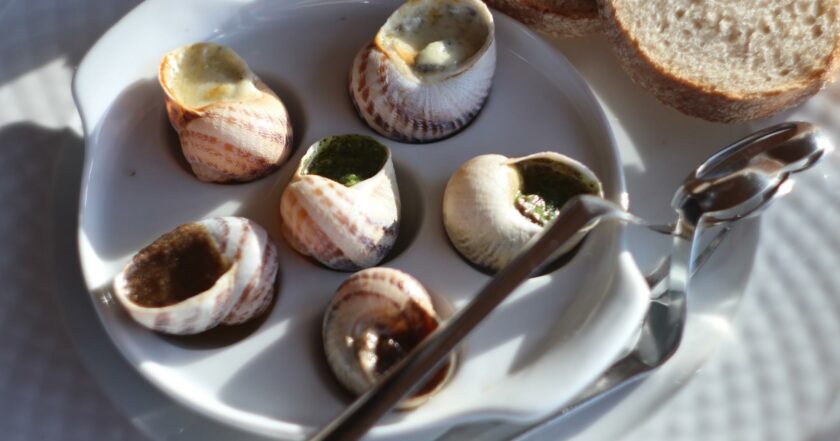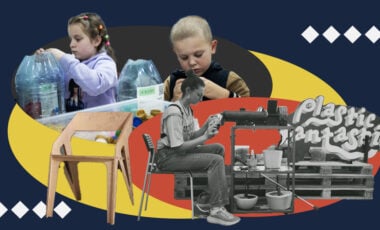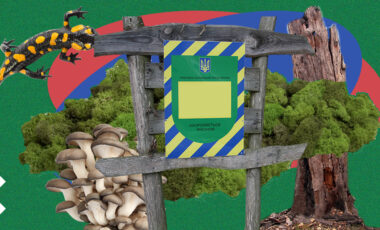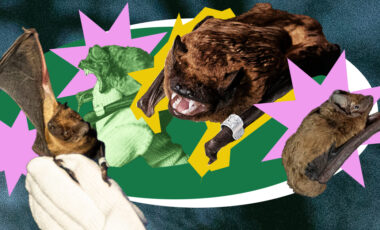From snails to frogs: how Ukrainians export French delicacies to Europe
We'll tell you about the entrepreneur who founded a snail farm near Lviv, following the example of Poland and Italy. Now his snails are successful not only in Ukraine but also in the European market.

There are many markets in Kyiv offering a much wider range than usual grocery stores. There you can find not only fresh oysters but also tentacles of octopuses, squids, and lobsters. They also offer to buy snails there, special ones, grown on a special farm near Lviv.
Rubryka decided to find out why and how they breed snails in Ukraine and visit the exquisite farm. It is half an hour's drive from Lviv, in the village of Yablunivka. It's easy to find: locals will show the way to the attraction without issue. They got accustomed to tourists coming to see the phenomenon and try the delicacies.
The first thing you'll see is a stylish building, a large barn next door, a couple of greenhouses, and… a garden? Our visit was in November, so the empty beds with wooden pallets were even more misleading.
Until the farm owner appeared, we looked around and understood that the pallet construction is clearly involved in growing snails.
But besides the beds with snail high-rises, the site had a greenhouse, restaurant, and two small ponds with frogs.
Fortunately, Orest Davydko, the farm's co-founder, soon joined us. It was he who founded it, and who promised to tell us why he decided to have such an unusual business for the local area.
Why do we need snails?
The farm's story began 5 years ago when Andrii Dziuban and Artem Khmyz opened a French cuisine restaurant in Lviv, "Tante Sophie," and realized that they had nothing to treat visitors with; they didn't have enough snail meat:
"At first we bought snails from collectors," Orest says. "These are people looking for ordinary snails in fields, near canals, and selling them to us. We collected and cooked them. Only when we sent our chef to study in France, we learned these snails were absolutely not suitable for consumption. One can't know where they crawl and what they eat. In addition, their meat is much harder than needed, and we concluded we should start breeding snails ourselves."
Snail farming technologies weren't used in Ukraine, so entrepreneurs went to fill gaps in knowledge in other countries: Italy and Poland, where they agreed about tours for a fee with the owners of snail farms:
"We first found a farm in Italy, learned everything we could learn there. However, the Ukrainian climate differs from the Italian one; we had to adapt to growing in the conditions we have. We thought neighboring Poland has similar natural conditions. In Poland, snail farming is developed at a fairly high level. We asked another farmer to show us what technology they use there. We saw everything, made our conclusions, and decided to try to implement a farm project in Ukraine, initially on 30 acres of land. We opened a small farm, and the first year, of course, was a failure. Few snails were produced but it was enough for our restaurant. The most important thing is that we discovered a prospect. In the summer of the following year, Andrii was at a food show in Italy, which led to us realizing that not only we were lacking this product. In Italy, many snail farms closed when entrepreneurs in Poland and Morocco went into business: land, water, and labor were cheaper there; they could dump prices."
According to Ukrainian legislation, every citizen may receive 2 hectares of land for agriculture, as did the farm owners, expanding their territory. This year, the number of residents on the farm increased: the owners learned from acquaintances about the MHP grant aimed at agricultural development, and won it. They invested the money in an experiment: they bought purebred frogs brought from France in the Odesa region and equipped 2 small ponds on the territory. The experience was successful. In June, journalists visited the farm to film a report and noticed tadpoles in the water. So now on the farm, you can try another French delicacy besides snails: frog legs.
Ukraine enters the world snail market
Now a new player has appeared on the world snail market — Ukraine, where labor and land are cheaper, and water is free if it's from your own well. All this makes Ukrainian snails competitive, and entrepreneurs decided that the venture, originally supposed to cover the restaurant's needs, could become a separate business.
"We could take additional hectares of land at once, hire more people, and scale. But the activity requires close attention and doesn't tolerate indifference. Any farm should employ workers who do care. They're hard to find. We decided to grow snails on our 2 hectares, and teach others who want to learn such business, sell brood stocks to partners, advise and jointly sell snails. The idea was great. Everything worked and the first partners appeared in 2017," Orest says.
How to prepare for export to Europe?
Business went on, and everything would be fine if not for quarantine, which practically killed the field. Restaurants don't work, and tourists don't come: "But we don't give up and still breed snails for our restaurants and teach people the culture of their consumption. However, supplies abroad have decreased."
Before the lockdown, Tante Snails set up snail exports to Spain. As it turned out, Ukrainian snails are highly valued in Europe: "I always ask tourists from abroad, for the sake of interest, not to please my ego, whose snails are more delicious: Ukrainian or European. I don't know if it's true or not, but everyone says ours are the best."
Despite the excellent taste of local snails, exporting them is not so simple. Orest says that because Ukraine is considered a third world country, our exporters need to settle many bureaucratic issues before supplying their products to Europe:
"We needed to confirm the registration of our refrigeration facilities. In Europe, they never did this. When buying snails in Poland, you just need to buy and transport them. We managed to agree, but again, as soon as everything started to work, the pandemic began."
Besides the coronavirus, 2020 brought other difficulties. Orest told us that this year they were supplied with poor quality food. Many snails didn't grow to the required size; shells were too fragile. Such snails cannot be served, because you can easily cut on the shell's broken edges, and fragments can get into snail meat. It's also dangerous. As a result, they had to dispose of the snails. Quality ones were enough only for deliveries to the restaurant. Such difficulties don't frighten farmers: "We are only getting stronger and understand that we may have to become a small compound feed mill," Orest says.
Refrigerator, hive, and bed: snail's life cycle
Starting the farm begins in late February when snails are removed from special refrigerators and removed from the anabiosis. In this state, they naturally spend 6-8 months in nature, underground, and in the spring, they wake up. On the farm, this process is accelerated by transferring the snails to a special greenhouse.
After entering the greenhouse, an ordinary person will never guess what it's for. The constructions inside don't look like anything else. One on the right is wide strips of dense black material, fixed vertically one after the other: it's called a hive. Rest is the horizontally stretched nets, used in the last stage of preparing snails to wash away excess soil from them.
At the end of winter, they remove the largest and strongest pre-selected snails from the anabiosis and settle them in the hive. Every night, they raise the humidity in the greenhouse and put carrots and fodder on the horizontal white surfaces. Snails are nocturnal inhabitants, who actively crawl in the dark and can even escape from the hive. To prevent this, special grooves are filled with salt. It burns the snails and they stay in the hive.
In such conditions, snails mate actively. In the third week, they lay eggs into pots with soil, being changed regularly. The eggs are selected and cleaned from the ground with brushes; it's a very laborious process. Some caviar is canned. It's considered a delicacy and can cost up to $1,000 per kilogram! Because of its characteristic creamy-white color, it's also called "Aphrodite's pearls." It doesn't look like fish roe. Its shell is denser, and the taste is slightly sour.
They transfer the rest of the cleaned caviar to thermo-correxes and transfer them to warm and humid incubators. After 2 weeks, the snails are born, come out of the correx, and drink water. This means that they can be "released to adult life" on the ground.

The process can be observed once a year, so farmers placed a stand with photos describing the life cycle of snails for clarity / Photo: Julia Dudnyk
They have already prepared the fields planting a hybrid of Chinese cabbage and rapeseed. The plant maintains a comfortable microclimate for snails, keeps moisture well, and is a useful food supplement.
They lay wooden pallets out in the beds to pour food on them: during the day snails hide in their shade, and at night they crawl to eat. Humidity in the beds is maintained by a special irrigation system.
How many snails can you grow on a farm?
In the hive, one snail can lay 80 to 150 eggs during the breeding season. In the wild, they breed less actively, so after mating in artificial conditions, snails die. On average, one specimen gives about 100 eggs, so with proper cultivation, you can multiply the "harvest" 100 times. According to Orest, the Tante Snails farm can grow up to 30 tons of snails a year per hectare. Just imagine, these are 3 trucks loaded with snails!
Where to taste snails?
When snails grow to the desired size, they are collected and washed on nets in greenhouses. But that's not all. Cooking snails takes 13 hours! Only after several stages of thermal treatment they are frozen and packed again. Later, the snails are baked in the oven and served with different sauces. We, of course, tasted them; anyone can do it right on the farm in a small, sun-drenched restaurant with a panoramic view. It has become a center of gastronomic abundances: lavender cookies, blackberry wine, Carpathian chardonnay, and even lollipops in snail shape, skillfully made by local masters. If this restaurant was in Europe, critics would definitely honor it with a Michelin star, because it's even worth changing the travel route for the sake of visiting. This criterion was initially the main one for obtaining a star.
They also sell snails from the farm in chain stores. Anyone can cook them, even at home, just by putting them in the oven for a while and adding sauces. Believe us, dinner will be curious, because eating snails is not only a delicious process but also very exciting.
The taste of snail meat resembles something between a conch shell and chicken. Besides taste, we have to emphasize that it's a pure protein, so the dish is nutritious and not harmful at all. Snails, unlike fish, are very picky about food and can not eat organically unclean foods, meaning their meat cannot contain any harmful additives. That's why they're so valued among fans of healthy eating.
A snail meat portion of 85 grams enriches you with the daily norm of vitamin E, half of the recommended daily allowance of selenium, one-sixth of the daily requirement of iron, and almost 10 percent of potassium, one-third of phosphorus, and two-thirds of magnesium. Thanks to tryptophan, after eating snails you will be in a good mood. We'll add that the mood will definitely improve if you wash them down with white dry wine.
Summing up, we can safely say that snail breeders in Ukraine have a future. Tante Snails proved this by borrowing experience from other countries and adapting it to our climate. It's possible that Ukraine will actively export another product to European countries as grain or iron ore, and new tourist destinations will emerge thanks to committed entrepreneurs.













































































